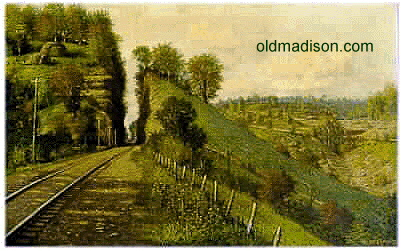
Madison's Railroad
The steep hillsides surrounding Madison, once almost barren due to lumber being harvested to build homes, are now thickly wooded. This luxuriant growth shrouds, sometimes even erases, many one time vantage points - and a few unusual attractions.
Perhaps the principal accomplishment now hidden from view is the Madison and Indianapolis Railroad incline that connects the hilltop area to the old city. Completed in 1841, the Madison
incline of 7,012 feet was - and remains today - the steepest grade
of any line-haul railroad in the country. The incline ascends 413
feet, or 311 feet per mile, giving the tracks a 5.89 percent grade.
The railroad incline may be reached on foot by driving west on Main Street to Cragmont, north on Cragmont to Third Street, then west on Third to its end only feet away from the tracks pointing to the sky. From there, the visitor must walk along the rails as they cross Crooked Creek via a huge embankment, before reaching the summit after passing under a stone bridge on the eastern edge of Madison State Hospital property. Hundreds of Irish laborers were imported into Madison to build the incline.
In January, 1836, General Noble, of Indiana, signed a huge internal improvements bill for Indiana that provided, among other things, for a Madison-Columbus Indianapolis-Lafayette railroad. At that time, Madison was Indiana's metropolis while Indianapolis was not much more than a clearing in the backwoods. Detailed surveys were started in March of 1836. Contracts were let the following September by the newly organized Madison and Indianapolis Railroad. Actual construction started September 16, 1836.
The principal obstacle confronting the Irish workers was the rugged terrain. A huge embankment had to be built over Crooked Creek. As dynamite blasted holes in the solid rock that underlay the topsoil, it produced earth and rocks of all sizes and composition. Workers labored to load wheelbarrows to start the fill material on its way to the Crooked Creek embankment.
The next obstacle was by far the largest, necessitating a "cut" 1, 1 50 feet long, 40 feet wide and up to 125 feet deep. It's been reliably estimated that this big "cut" produced no fewer than 175,000 yards of materials, or 250,000 tons of earth and rock. While today, that much excavation might take a month or so, back in the 1830's it took five years of hard, back breaking labor.
500,000 TONS OF EARTH
The entire task, spectacular even by today's standards, wasn't complete until 1841 and it's been estimated that close to 500,000 tons of earth and rock were hewn out of the west side of Irish Hollow.
BROUGH'S FOLLY
A provision of an 1852 contract called for a new route between Madison and North Madison, since the original incline had proven a substantial operating problem. Hence, in 1853, a project was developed by M&I President John Brough (pronounced (Bruff), whereby a lower grade line, 4.75 miles long, was to be constructed, leaving Madison by a gradually ascending grade along the face of hills to the west of the city, then entering Clifty Creek Valley by means of a tunnel, following Clifty Creek to a point near its head and by use of a second tunnel emerge on the upland proceeding northeast to a point on the railroad about a mile north of North Madison.The sum of $309,479 - over $6 million of today's dollars - had been spent on this project before financial difficulties made it imperative to suspend all work.
In 1847, the M&I, tiring of slow motion up the historic grade, secured a light 12 ton 0-8-OT locomotive, built by M.W. Baldwin and named "The Marion". Its 12" by 18" cylinders and 54" drivers literally "couldn't make the grade". M&I master mechanic Andrew Cathcart conceived a rack and pinion system to solve the problem and personally supervised construction of a Baldwin locomotive at its Philadelphia plant.
All of its shortcomings notwithstanding, the 'M.C. Bright" worked well enough to be dependable.
Rack and pinion power was used to scale the Madison hill from 1848-1868.
ADVENT OF THE REUBEN WELLS
Master mechanic, Reuben Wells, then designed and built in his Jeffersonville shops the famous locomotive that bears his name and is now on permanent display at the Indianapolis Children's Museum. "The Reuben Wells' was the first engine to work the big hill successfully by adhesion .
It went into service in July of 1868 and remained in active use until 1898, after which it served as a back-up through 1905.
"Reuben Wells" was "subbed" by the "M.G. Bright" which ran the hill road until a Sunday morning in 1877 when water tipping off the crown sheet during the descent triggered a thunderous explosion that killed two. The line saw its first coal burner in 1895. Engine #8434 served the incline until 1932, assisted by other locomotives.
ACCIDENT KILLS TWO
October 25, 1943, engine #8S6S with a cut of about 12 cars, got away from engineer J.K. Cummings and crashed at the bottom of the incline, throwing
Conductor B.E Conner from the top of a freight car. Both men were killed. The wrecker train, sent to clear the tracks, also went out of control and crashed, but killed no one.
Today, the incline is used as needed by the Madison Port Authority, which is responsible for its upkeep.
Back
Copyright 1997. All rights reserved.
